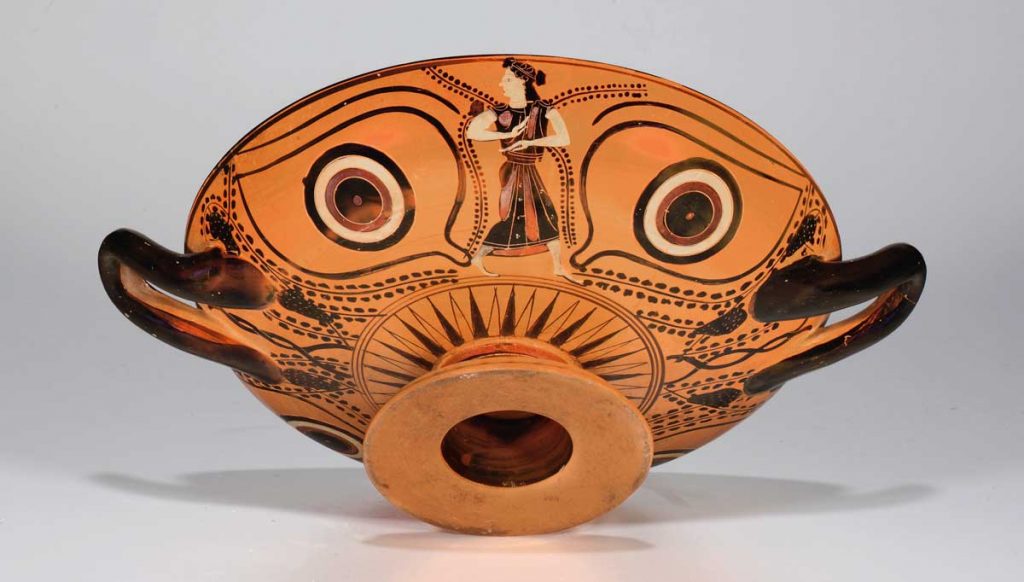
Attic Black-Figure Eye Cup is located in the Antiquities gallery on the first floor of the Museum. Audio guide length: 3 minutes, 40 seconds.
Link to next piece in highlights tour: Untitled, by Walter H. Williams Jr.
Transcript
This Attic Black-Figure Eye Cup is a wine cup from ancient Greece. It was made around 510 B.C.E. The piece is made of terracotta, a red baked clay, painted in red, black, and white. The top half of the cup forms a wide, shallow bowl with thick, looped handles. The bottom half is made up of a short stem with a flared base. It is very symmetrical—a clue that it was created on a potter’s wheel. It is quite large—about one foot wide and four inches tall.
The bottom of this cup is decorated with designs common in Greek pottery. Pairs of rings dominate either side of the cup. The rings alternate black, white, red, and black again in a pattern also similar to a bulls-eye. A geometric starburst pattern circles the stem, and twisted lines surrounded by black dots circle the handles. These tendrils and dots together resemble abstract grape vines.
On either side of the outer walls of the cup are realistic, human-like figures. On one side is Hercules, the Greek hero. On the other side is an image of a woman energetically clapping her hands in dance. She is a Maenad, a female follower of the god of wine.
[If you would like further description and analysis of this cup—including a hidden surprise—please continue listening or reading.]
Hercules is painted in black and wears a lion skin. He is kneeling and pulling back an arrow, preparing to shoot. On the other side, the skin of the dancing Maenad is painted white and she wears a black, draped robe with red folds. The abstract grape vine patterns and image of a Maenad link this cup to the Dionysian revels, rituals involving intoxicants, music, and dance to induce a trance-like state.
Cups like this one were often used during banquets. At these events, philosophers would gather to talk and drink wine. Friends would pass this wine cup from person to person, drinking from the same vessel. When a guest held the drink in his hands and looked inside the cup, all he would see is a simple design of orange and black rings in a bulls-eye pattern. Only when he lifted the cup up to his lips would the intricate design on the bottom become visible to other guests.
Concealed among the designs on the bottom of the cup is a hidden surprise—a cartoon-like face! When the cup is lifted, the bulls-eye ring designs transform into the bright whites of eyes, red irises, and staring, black pupils. The shape of the eyes is enhanced by swooping lines that evoke eyelids and brows. The looped handles on either side of the cup become large ears, and the vessel’s hollow base forms a round, gaping mouth. Combined together, the face resembles theatrical masks from ancient Greece. When a party guest drank from the cup, the mask would cover his face—a humorous sight for the other friends. The design of this cup can be understood as a metaphor for its use. The cup’s design is very simple from the perspective of the person drinking the wine. The decorations on the bottom of are meant for others’ amusement, demonstrating the social, interactive function of wine in ancient Greece.
Link to next piece in highlights tour: Untitled, by Walter H. Williams Jr.